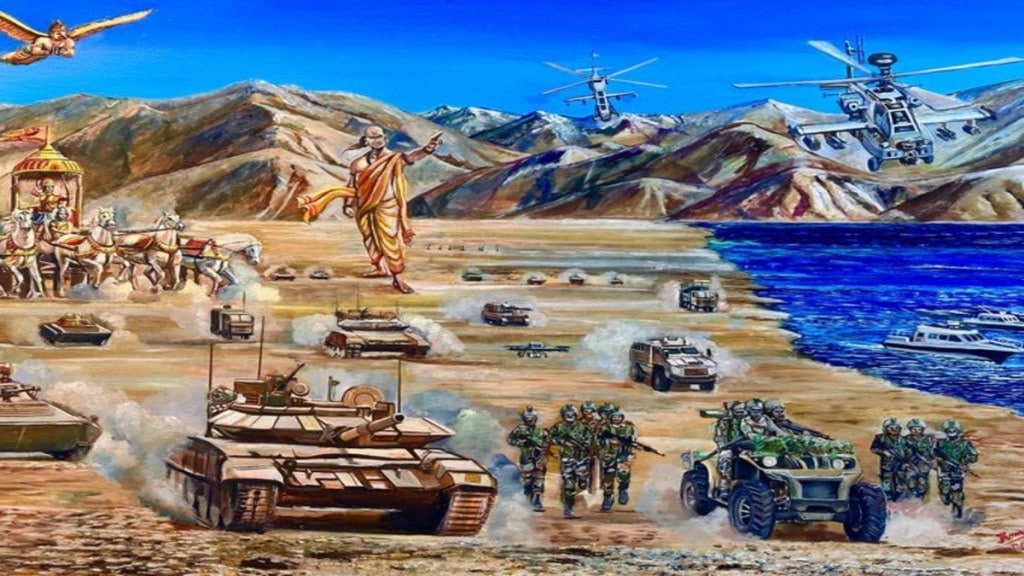The Indian Army has replaced a painting depicting the historic 1971 Bangladesh war surrender with a new artwork in the Army Chief’s lounge, sparking mixed reactions among military veterans. The new painting, titled Karam Kshetra – Field of Deeds, shifts the narrative towards portraying the Army as a “guardian of Dharma,” emphasising its role in upholding justice and protecting national values while reflecting its modern capabilities.
A New Symbol for the Indian Army
The updated artwork, ‘Karam Kshetra – Field of Deeds’ created by Lt Col Thomas Jacob of the 28 Madras regiment, weaves together themes of mythology, philosophy, and advanced military strength.
It features a backdrop of snow-capped mountains, the Pangong Tso lake in Eastern Ladakh on the right, and Garuda and Krishna’s chariot on the left and an array of modern assets such as tanks, infantry vehicles, Light Combat Helicopters, and Apache attack helicopters.
Additionally, the painting incorporates symbolic elements like Krishna’s chariot and Chanakya, representing strategic wisdom rooted in Indian philosophy. It reflects the Army’s evolution into a technologically sophisticated, integrated force, while linking its contemporary role with ancient principles of righteousness and justice.
This change aligns with a broader effort to study ancient Indian texts and integrate their strategic insights into military operations. The Army has sought to develop an “indigenous strategic vocabulary” to complement its modern capabilities.
Criticism from Veterans
The decision to replace the 1971 surrender painting has drawn criticism from many veterans. The original artwork depicted the signing of the Instrument of Surrender by Lt Gen A A K Niazi of Pakistan in Dhaka, marking the end of the war and the creation of Bangladesh. It was seen as a testament to India’s military triumph and its assertion on the global stage.
Critics argue that the original painting represented a pivotal moment in India’s modern military history, symbolising unity and strategic prowess. The removal of this historical artefact from a space where foreign dignitaries and military leaders are hosted has raised questions about the Army’s priorities in balancing its heritage with its contemporary identity.
Balancing Legacy and Modernity
While the new painting emphasises the Army’s preparedness and its alignment with India’s cultural roots, some believe it risks overshadowing a legacy built on tangible achievements. The 1971 surrender is not just a military success but a moment of national pride, highlighting India’s ability to influence regional geopolitics decisively.
The Army has not disclosed the current location of the original painting, leaving its status uncertain. As the institution moves towards integrating cultural and philosophical elements into its strategic framework, the response to this symbolic change highlights the importance of grounding the future in a shared understanding of the past.
This development reflects an ongoing debate about how India’s military identity can reconcile its historical achievements with aspirations for a modern, indigenous approach to defence and strategy.

